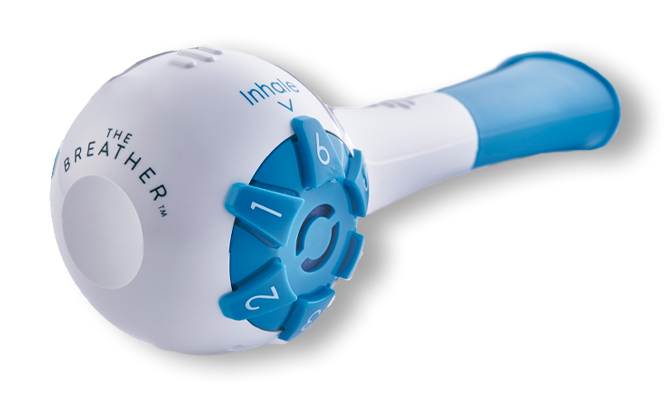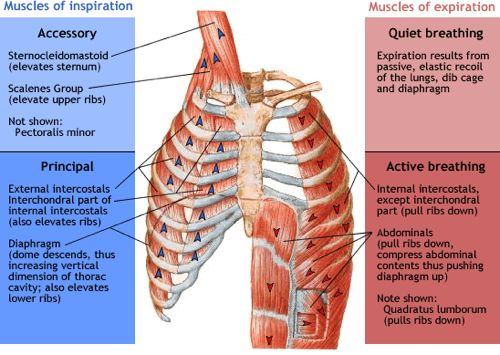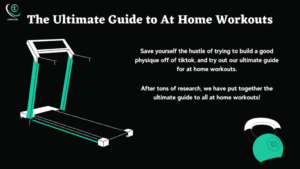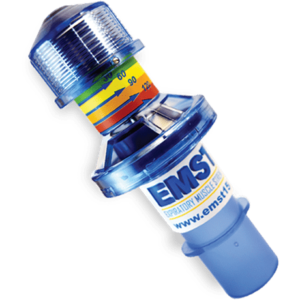Expiratory Muscle Strength Training (EMST) boosts respiratory muscle power. It’s a proven method to enhance cough and swallow functions.
This specialized training targets the muscles involved in breathing out, which are crucial for vital functions such as speech, cough, and swallowing. EMST is often used by individuals with conditions that affect respiratory strength, such as Parkinson’s disease, multiple sclerosis, and spinal cord injuries, as well as by athletes and singers looking to improve their performance.
The training typically involves the use of a handheld device, which provides resistance during exhalation, therefore strengthening the muscles over time. As a non-invasive and straightforward therapy, EMST can significantly contribute to improved quality of life by assisting with better breath control, helping to clear airways, and reducing the risk of pulmonary complications.

Credit: www.northernspeech.com
Breathe In, Breathe Out: The Importance Of Strong Expiratory Muscles
Our breath powers everything we do. Strong expiratory muscles make each breath count.
The Anatomy Of Breathing
Breathing is not just about inhaling. It is a complex dance of muscles and air.
| Part | Function |
|---|---|
| Diaphragm | Pulls down to let air in. |
| Rib Muscles | Lift ribs for more space. |
| Expiratory Muscles | Push air out forcefully. |
The Role Of Expiratory Muscles In Overall Health
- Supports breathing: These muscles control breath outflow.
- Boosts stamina: More breath control extends exercise time.
- Enhances speech: Strong muscles improve voice power.
- Expiratory muscles press air out.
- Air pressure turns to sound.
- Controlled breathing sustains communication.

Credit: www.physio-pedia.com
The Essentials Of Expiratory Muscle Strength Training (emst)
Expiratory Muscle Strength Training (EMST) boosts breath and cough functions. It aids those with breathing issues. By exercising the muscles we use to breathe out, EMST enhances lung capacity and strength. Let’s explore EMST and its devices.
Defining Emst
EMST is a technique to improve the power of expiratory muscles. These muscles help in coughing and clearing airways. Exercises make breathing easier and safer.
People with neurological conditions, aging adults, and singers use EMST. It works for anyone looking to boost respiratory strength.
The Mechanism Behind Emst Devices
EMST devices involve resistance against breaths out. This resistance creates a workout for lung muscles. The user blows into a mouthpiece connected to a valve. The valve provides resistance which is adjustable to suit different training levels.
- Choose a device: Find one that fits snugly and adjusts easily.
- Set the resistance: Start low and increase as muscles strengthen.
- Regular practice: Consistency is key for improvement.
| Activity | Benefit |
|---|---|
| EMST | Enhances respiratory muscle function |
| Coughing | Helps clear airways |
| Breathing | Improves oxygen intake |
Clinical Background: Who Needs Emst?
Clinical Background: Who Needs EMST?
Expiratory Muscle Strength Training (EMST) is a therapy. Doctors use it to help patients breathe better. Some people have weak breathing muscles. EMST can make these muscles stronger. This therapy is for many kinds of conditions. People with breathing trouble get EMST to feel better.
Patient Profiles For Emst
- Older adults with less breath.
- People who had a stroke and need better speech and swallow.
- Those with Parkinson’s for stronger voice.
- Neurological conditions patients for safe eating.
- Sportspeople wanting more stamina.
Addressing Chronic Respiratory Conditions
| Condition | Benefits of EMST |
|---|---|
| COPD | Better breathing control |
| Asthma | Reduce attacks, easier breathing |
| Cystic Fibrosis | Clear airways, stronger lungs |
| Sleep Apnea | Quiet sleep, more energy |
How Emst Transforms Breathing
Expiratory muscle strength training (EMST) is a game-changer for breathing. It turns weak breaths into powerful ones. With EMST, your lungs work better. This means more air in and out with each breath. Stronger breathing muscles lead to big changes in your health and daily life.
Physical Benefits Of Enhanced Expiratory Muscle Strength
More air means more oxygen for your muscles. Stronger muscles help your body in many ways.
- Easy Breathing: Fill your lungs with less effort.
- Better Cough: Clear your throat well.
- Stamina: Do more without getting tired.
- Healthier Lungs: Fight off chest infections.
Improvements In Daily Activities And Exercise
With EMST, daily tasks feel simpler. Strong breathing lifts your exercise game too.
| Activity | Before EMST | After EMST |
|---|---|---|
| Walking | Short of breath | Walk longer |
| Climbing Stairs | Need breaks | Climb with ease |
| Playing Sports | Get winded fast | Play harder |
| Gardening | Tire quickly | Garden longer |
Lift more, run farther, and smile wider with stronger breathing from EMST.
Your Emst Journey: Getting Started
Expiratory Muscle Strength Training (EMST) is the key to breathe better. It helps your lungs. It gives strength to your muscles. No matter the reason, starting EMST is a smart move.
Selecting The Right Emst Device
Your EMST device is your workout buddy. It should fit your needs. Here’s what to do:
- Research – Look for options. Read reviews. Find the best.
- Ask – Get advice from a doctor or therapist.
- Test – If possible, try before buying.
Creating A Personal Emst Routine
Consistency is your golden rule here. To begin:
- Plan – Set your goals. Write them down.
- Schedule – Pick a time each day for your routine.
- Track – Keep records of your progress.
| Week | Duration | Repetitions |
|---|---|---|
| 1-2 | 5 min | 5 sets |
| 3-4 | 10 min | 10 sets |
Remember, start slow. Gradually increase intensity. Listen to your body. Enjoy each step forward.
Integrating Emst Into Rehabilitation Programs
Expiratory Muscle Strength Training (EMST) strengthens breathing muscles. It’s key in many rehab cases. EMST increases airflow, boosts cough force, and improves swallowing. Its integration into rehab programs can offer significant benefits to patients needing respiratory support.
Cases For Respiratory Rehab
Respiratory rehab helps many conditions:
- Chronic Obstructive Pulmonary Disease (COPD): EMST can enhance breath control.
- Parkinson’s Disease: Improves speech and swallowing in patients.
- Stroke Victims: Helps regain breathing and coughing strength.
- Athletes: Boosts performance in high-endurance sports.
Multidisciplinary Approaches To Breathing Training
Effective EMST involves multiple specialists. Each plays a role in patient recovery.
| Specialist | Role |
|---|---|
| Physical Therapists | Design exercise plans. |
| Respiratory Therapists | Offer expertise in breath work. |
| Speech-Language Pathologists | Treat speech and swallowing issues. |
| Nurses | Monitor patient progress. |
Tracking Progress And Adjusting Training Intensity
As you commit to Expiratory Muscle Strength Training (EMST), tracking your progress is crucial. Regularly measuring improvements ensures you stay on the right path. Keeping tabs on your achievements motivates and guides adjustments in training intensity. This leads to better respiratory muscle strength and overall wellness.
Setting And Evaluating Goals
Setting clear goals for EMST keeps you focused and driven. Whether it’s enhancing breath for daily activities or improving vocal strength, goals should be specific, measurable, and time-bound.
- Define clear objectives: Better breath control during exercise or stronger cough reflex.
- Use tools like a peak flow meter to measure progress.
- Keep a training journal: Note your daily exercises and achievements.
Every few weeks, assess your outcomes. If goals are consistently met, it might be time to intensify.
When To Increase Emst Load
Increase training load when current exercises become less challenging. It indicates your muscles have adapted and grown stronger.
| Indicator | Action |
|---|---|
| Consistently meet current goals | Consider increasing load |
| No significant fatigue post-training | Gradually add intensity |
| Peak flow meter readings plateau | Consult with a specialist |
Introduce higher resistance gradually. Monitor your body’s response to avoid overtraining. Consult with healthcare professionals to adjust your EMST program effectively.

Credit: www.facebook.com
Potential Pitfalls And Common Misconceptions
Expiratory Muscle Strength Training (EMST) strengthens breathing muscles. It’s like a gym for your lungs. Yet, some people think wrong things about EMST. They might overdo it or not do it right. So, let’s clear up these mistakes and help you train safely.
Avoiding Injury And Overtraining
Training too much can hurt. Your muscles need rest. If they don’t get it, they get sore or injured. Follow these rules to stay safe:
- Start slow, then go up.
- Use the right technique.
- Rest between sessions.
- Listen to your body.
- Get advice from a pro.
Remember, more training is not always better. Your muscles grow when they rest.
Separating Emst Myths From Facts
EMST has myths around it. Let’s sort the real from the fake:
| Myth | Fact |
|---|---|
| EMST is only for athletes. | All people can do EMST. |
| You see results right away. | It takes time to build muscles. |
| EMST is hard and hurts. | Done right, it’s safe and feels good. |
Learning the truth about EMST helps you use it the right way. And you’ll get the most out of it.
Synergy With Other Therapeutic Practices
Expiratory Muscle Strength Training (EMST) boosts breathing. Imagine it working with other health practices for better results. Combining EMST with activities like yoga, Pilates, and aerobic exercises enhances benefits. It’s like teaming up superheroes for greater strength!
Emst And Yoga Or Pilates
EMST pairs well with yoga and Pilates. These exercises focus on breath control and core strength. Together, they create a powerful duo for lung health and stability. See how they work in unison:
- Yoga uses deep breathing, improving EMST effectiveness.
- Pilates strengthens the diaphragm, complementing EMST.
- Both improve posture, aiding better breathing.
Harmonizing Emst With Aerobic Exercise
Aerobic exercise makes the heart and lungs work hard. Combining it with EMST enhances endurance. Here’s how they team up:
| Aerobic Exercise | Benefits with EMST |
|---|---|
| Running | Boosts stamina, improved with stronger breathing muscles. |
| Cycling | Increases lung capacity; EMST helps use it better. |
| Swimming | Teaches breath control, enhanced with EMST training. |
By merging EMST with these exercises, breath becomes more efficient. It’s like getting a natural boost in energy and health. Training the breath supports all aspects of well-being.
Consistency Is Key: Maintaining Long-term Emst Benefits
Consistency is Key: Unlocking the long-term benefits of Expiratory Muscle Strength Training (EMST) demands perseverance. To enjoy enduring improvements in respiratory strength, one must train regularly. EMST offers more than just short-term gains; it promises ongoing enhancements in breathing and quality of life. But these benefits linger only through steady, consistent practice.
Sustaining Motivation Over Time
Maintaining a routine can feel tough. To keep motivation high, consider these tips:
- Set clear goals: Know what you’re working towards.
- Track progress: Seeing improvement fuels further effort.
- Reward milestones: Treat yourself for reaching targets.
- Vary exercises: Keep sessions fresh and exciting.
Incorporating Emst Into Lifestyle Changes
To make EMST a natural part of daily life, integrate it into other habits:
| Time of Day | EMST Activity |
|---|---|
| Morning routine | Pair with stretching or breakfast setup |
| Lunch break | Quick session post-meal |
| Evening unwind | Before or after brushing teeth |
Small steps lead to big changes. Make EMST part of your routine for long-lasting health benefits.
Frequently Asked Questions On Expiratory Muscle Strength Training
How Do You Train Expiratory Muscles?
To train expiratory muscles, perform breathing exercises like pursed-lip breathing, use a spirometer, or engage in activities like blowing balloons. Regular practice and techniques like the forced expiration technique can also strengthen these muscles.
What Is Expiratory Muscle Training For Dysphagia?
Expiratory muscle training (EMT) is a therapeutic technique strengthening the muscles used during exhalation, aiding in the improvement of swallowing function in dysphagia patients.
What Does Expiratory Muscle Strength Training Emst Primarily Target?
Expiratory muscle strength training (EMST) primarily strengthens the respiratory muscles used for breathing out. It improves cough and swallowing functions.
What Is The Best Expiratory Muscle Strength Trainer?
The POWERbreathe is widely recognized as a leading expiratory muscle strength trainer, offering both effectiveness and ease of use.
What Is Expiratory Muscle Strength Training?
Expiratory Muscle Strength Training (EMST) is a technique designed to improve the strength of respiratory muscles, often using a device to create resistance during exhalation.
How Does Emst Benefit Lung Function?
Regular EMST can enhance lung capacity, improve cough strength, and reduce the risk of respiratory complications by conditioning expiratory muscles.
Can Emst Help With Speech Disorders?
Yes, EMST has been shown to help patients with speech disorders by strengthening muscles involved in voice production and breath support.
Conclusion
To sum up, expiratory muscle strength training (EMST) offers a promising approach for respiratory health. Practitioners in speech-language pathology and respiratory therapy can leverage EMST for patient benefits. As breath is essential to life, optimizing its strength should be a priority.
For optimal results, ensure proper technique and consistency in your EMST regimen.
















